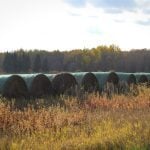
Tag Archives plant nutrition

FEED ME: Can well-fed plants fend off diseases and insects?
We examine an Idaho farmer’s program for crop self-defence

Understanding soil phosphorus, part 1
Agronomy Management: Rotations and fertilizer management have dramatic effects on pools of organic and inorganic P

Les Henry: Acid soils. A wake-up call
At the farm level, soil test, soil test, soil test

Why is there no mention of sulphur?
The reasons behind this nutrient’s anonymity

The importance of molybdenum
Molybdenum (Mo) is important to the growth of all plants, including your canola

Speeding up crop maturity
Consider these nine factors to make sure you have time to get your crop in the bin in 2020

Crop advisor casebook: Pigtailing barley presents a problem
A Crop Advisor's Solution from the July 16, 2019 issue of Grainews

Copper deficiencies can reduce wheat yields
Q & A with Nutrien Ag Solutions

Why did my cereal crop lodge?
Practical Research: Was it disease? Too much nitrogen? Or was it a copper deficiency in your soil?

How’s your moly doing out there?
Molybdenum was once known as ‘poor man’s lime’ for a good reason


